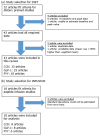How Satiating Are the 'Satiety' Peptides: A Problem of Pharmacology versus Physiology in the Development of Novel Foods for Regulation of Food Intake
- PMID: 31277416
- PMCID: PMC6682889
- DOI: 10.3390/nu11071517
How Satiating Are the 'Satiety' Peptides: A Problem of Pharmacology versus Physiology in the Development of Novel Foods for Regulation of Food Intake
Abstract
Developing novel foods to suppress energy intake and promote negative energy balance and weight loss has been a long-term but commonly unsuccessful challenge. Targeting regulation of appetite is of interest to public health researchers and industry in the quest to develop 'functional' foods, but poor understanding of the underpinning mechanisms regulating food intake has hampered progress. The gastrointestinal (GI) or 'satiety' peptides including cholecystokinin (CCK), glucagon-like peptide 1 (GLP-1) and peptide YY (PYY) secreted following a meal, have long been purported as predictive biomarkers of appetite response, including food intake. Whilst peptide infusion drives a clear change in hunger/fullness and eating behaviour, inducing GI-peptide secretion through diet may not, possibly due to modest effects of single meals on peptide levels. We conducted a review of 70 dietary preload (DIET) and peptide infusion (INFUSION) studies in lean healthy adults that reported outcomes of CCK, GLP-1 and PYY. DIET studies were acute preload interventions. INFUSION studies showed that minimum increase required to suppress ad libitum energy intake for CCK, GLP-1 and PYY was 3.6-, 4.0- and 3.1-fold, respectively, achieved through DIET in only 29%, 0% and 8% of interventions. Whether circulating 'thresholds' of peptide concentration likely required for behavioural change can be achieved through diet is questionable. As yet, no individual or group of peptides can be measured in blood to reliably predict feelings of hunger and food intake. Developing foods that successfully target enhanced secretion of GI-origin 'satiety' peptides for weight loss remains a significant challenge.
Keywords: appetite; cholecystokinin; dietary studies; glucagon-like peptide-1; infusion studies; peptide YY; satiety.
Conflict of interest statement
S.D.P held the Fonterra Chair in Human Nutrition at the University of Auckland, Auckland, New Zealand; and funding from the NZ National Science Challenge High Value Nutrition programme. The authors declare no other conflicts of interest.
Figures







Similar articles
-
Small intestinal protein infusion in humans: evidence for a location-specific gradient in intestinal feedback on food intake and GI peptide release.Int J Obes (Lond). 2017 Feb;41(2):217-224. doi: 10.1038/ijo.2016.196. Epub 2016 Nov 4. Int J Obes (Lond). 2017. PMID: 27811949 Clinical Trial.
-
Comparison of postprandial profiles of ghrelin, active GLP-1, and total PYY to meals varying in fat and carbohydrate and their association with hunger and the phases of satiety.J Clin Endocrinol Metab. 2013 May;98(5):E847-55. doi: 10.1210/jc.2012-3835. Epub 2013 Mar 18. J Clin Endocrinol Metab. 2013. PMID: 23509106 Clinical Trial.
-
Use of satiety peptides in assessing the satiating capacity of foods.Physiol Behav. 2012 Jan 18;105(2):483-8. doi: 10.1016/j.physbeh.2011.08.033. Epub 2011 Sep 2. Physiol Behav. 2012. PMID: 21907727
-
Neuroendocrine control of food intake.Nutr Metab Cardiovasc Dis. 2008 Feb;18(2):158-68. doi: 10.1016/j.numecd.2007.06.004. Epub 2007 Dec 3. Nutr Metab Cardiovasc Dis. 2008. PMID: 18061414 Review.
-
Gut hormones as peripheral anti obesity targets.Curr Drug Targets CNS Neurol Disord. 2004 Oct;3(5):379-88. doi: 10.2174/1568007043336950. Curr Drug Targets CNS Neurol Disord. 2004. PMID: 15544446 Review.
Cited by
-
Satiety of Edible Insect-Based Food Products as a Component of Body Weight Control.Nutrients. 2022 May 21;14(10):2147. doi: 10.3390/nu14102147. Nutrients. 2022. PMID: 35631288 Free PMC article.
-
New Zealand Bitter Hops Extract Reduces Hunger During a 24 h Water Only Fast.Nutrients. 2019 Nov 13;11(11):2754. doi: 10.3390/nu11112754. Nutrients. 2019. PMID: 31766216 Free PMC article. Clinical Trial.
-
Effects of prebiotic dietary fibers and probiotics on human health: With special focus on recent advancement in their encapsulated formulations.Trends Food Sci Technol. 2020 Aug;102:178-192. doi: 10.1016/j.tifs.2020.06.010. Epub 2020 Jun 23. Trends Food Sci Technol. 2020. PMID: 32834500 Free PMC article. Review.
-
Comparisons of Soybean and Wheat; in the Focus on the Nutritional Aspects and Acute Appetite Sensation.Foods. 2022 Jan 29;11(3):389. doi: 10.3390/foods11030389. Foods. 2022. PMID: 35159539 Free PMC article.
-
Does a Higher Protein Diet Promote Satiety and Weight Loss Independent of Carbohydrate Content? An 8-Week Low-Energy Diet (LED) Intervention.Nutrients. 2022 Jan 26;14(3):538. doi: 10.3390/nu14030538. Nutrients. 2022. PMID: 35276894 Free PMC article. Clinical Trial.
References
-
- Chambers L., McCrickerd K., Yeomans M.R. Optimising foods for satiety. Trends Food Sci. Technol. 2015;41:149–160. doi: 10.1016/j.tifs.2014.10.007. - DOI
-
- Poppitt S.D., Shin H.S., McGill A.T., Budgett S.C., Lo K., Pahl M., Duxfield J., Lane M., Ingram J.R. Duodenal and ileal glucose infusions differentially alter gastrointestinal peptides, appetite response, and food intake: A tube feeding study. Am. J. Clin. Nutr. 2017;106:725–735. doi: 10.3945/ajcn.117.157248. - DOI - PubMed
-
- Giezenaar C., Luscombe-Marsh N.D., Hutchison A.T., Standfield S., Feinle-Bisset C., Horowitz M., Chapman I., Soenen S. Dose-dependent effects of randomized intraduodenal whey-protein loads on glucose, gut hormone, and amino acid concentrations in healthy older and younger men. Nutrients. 2018;10 doi: 10.3390/nu10010078. - DOI - PMC - PubMed
Publication types
MeSH terms
Substances
LinkOut - more resources
Full Text Sources
Medical
Research Materials

